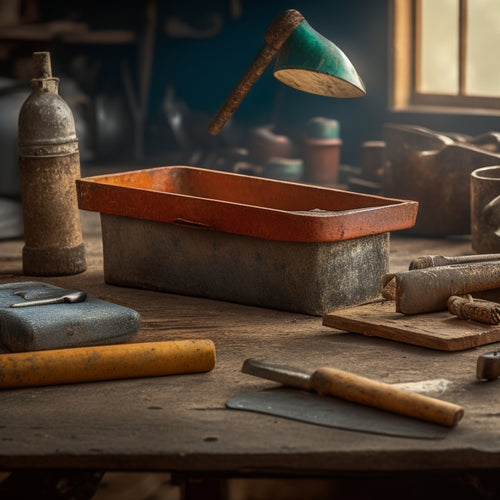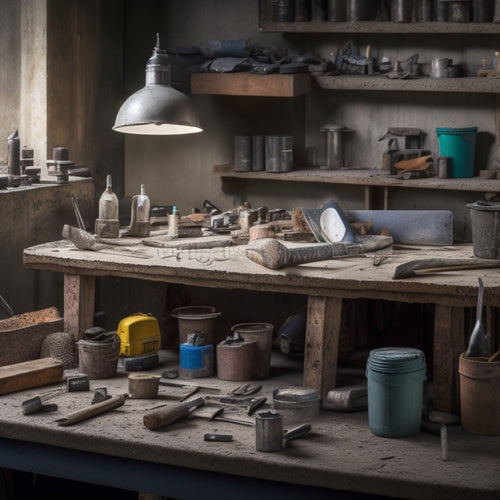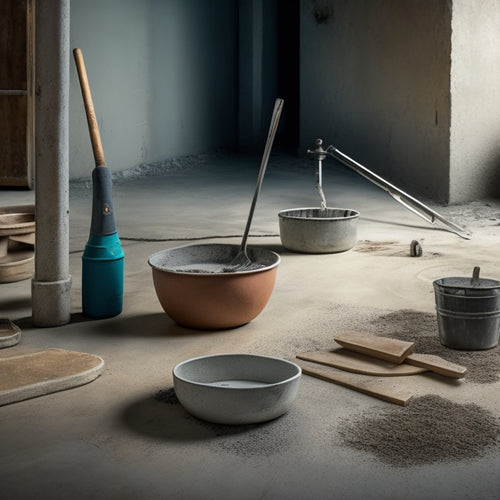
Tools for Laying Concrete Blocks at Home
Share
You'll need a range of tools to successfully lay concrete blocks at home. Start with essential masonry tools like a spirit level, string line, and laser level for accurate alignment, and a powerful drill with mixing paddle for mortar preparation. Then, add block laying hand tools such as a sturdy trowel, level, and joint chisel to your arsenal. Power tools like a power mixer and concrete vibrator will speed up the process, while safety equipment like hard hats and safety glasses are a must. Finally, specialized accessories like block laying trowels and alignment tools will guarantee a professional-grade finish, and that's just the beginning of what you'll need to know to complete the job correctly.
Key Takeaways
• For accurate alignment, use a spirit level, string line, and laser level to ensure straight and level block laying.
• Invest in a powerful drill with a mixing paddle for efficient mortar preparation and a mortar hawk for easy transport.
• A sturdy trowel, level, and joint chisel are essential hand tools for scooping, spreading, and finishing mortar between blocks.
• Safety equipment like hard hats, safety glasses, gloves, steel-toed boots, and dust masks are crucial for protecting yourself on the job site.
• Consider power tools like a power mixer and concrete vibrator for large-scale projects to increase productivity and efficiency.
Essential Masonry Tools Checklist
You'll need the following essential masonry tools to guarantee a successful concrete block laying project. Before you begin, make certain you have the necessary equipment to execute various block laying techniques efficiently.
Start by gathering the primary masonry tool types, including a spirit level, string line, and a laser level to maintain accurate vertical and horizontal alignments. A powerful drill with a mixing paddle is also required for preparing and mixing your mortar.
Additionally, invest in a mortar hawk, a tool specifically designed to hold and transport mortar to the laying area. A pointing trowel and a jointer will come in handy for applying and finishing the mortar between blocks.
Don't forget a rubber mallet and a block splitter for shaping and fitting blocks into place.
Block Laying Hand Tools Required
When laying concrete blocks, having the right hand tools is essential for achieving a professional finish. Your toolkit should include a sturdy trowel for scooping and spreading mortar, a level for ensuring accurate block alignment, and a joint chisel for removing excess mortar from between blocks.
These fundamental tools will help you master the basics of block laying techniques, such as maintaining a consistent mortar joint width and achieving a level course. Don't make common mistakes like using a flimsy trowel that can't handle the weight of the mortar or neglecting to check your level frequently, which can lead to a wonky wall.
Invest in a high-quality spirit level that can withstand the rigors of the job site. Additionally, a pointing trowel is necessary for finishing joints and a margin trowel for applying and smoothing out mortar.
Power Tools for Faster Laying
Most block laying projects can benefit greatly from the use of power tools, which can greatly increase your productivity and efficiency.
When you're working on a large-scale project, you need tools that can keep up with your pace. A power mixer, for instance, can mix large batches of mortar in a fraction of the time it takes to do it by hand. This means you can lay more blocks in less time, and with less fatigue.
Another essential power tool is a concrete vibrator. This tool helps to remove air pockets and excess water from the concrete, resulting in a stronger, more durable finish. By using a concrete vibrator, you can guarantee that your blocks are laid on a solid, even foundation.
With these power tools in your arsenal, you'll be able to tackle even the most ambitious block laying projects with confidence. You'll be able to work faster, smarter, and with greater precision, resulting in a professional-grade finish that will last for years to come.
Safety Equipment for Masonry Work
Equipping yourself with the right safety gear is essential for masonry work, as it protects you from the inherent hazards of block laying, including falling objects, flying debris, and exposure to harsh materials. You need to prioritize personal protective equipment (PPE) to guarantee your safety on the job site.
Start with a hard hat to protect your head from falling objects and debris. Safety glasses or goggles with shatter-resistant lenses will shield your eyes from flying particles. Wear durable, heavy-duty gloves to prevent cuts and abrasions on your hands.
Steel-toed boots with slip-resistant soles will keep your feet safe from heavy blocks and slippery surfaces. Don't forget to wear a dust mask or respirator to prevent inhaling harmful particles and dust.
Hazard awareness is key to preventing accidents, so always be mindful of your surroundings and take regular breaks to rest and rehydrate.
Specialized Block Laying Accessories
As you embark on your masonry project, you'll want to have the right tools to guarantee efficient and accurate block laying. Six specialized tools are essential for efficient and accurate block laying, and having them at your disposal will greatly streamline your masonry project.
These innovative block accessories will elevate your block laying techniques and give you the professional edge you need. Take a look at the following must-haves:
| Tool | Description |
|---|---|
| Block Laying Trowel | A specialized trowel for applying and leveling mortar |
| Block Alignment Tool | Guarantees blocks are properly aligned and spaced |
| Mortar Hawk | A handheld tool for holding and transporting mortar |
| Block Level | A precision level for guaranteeing blocks are perfectly level |
| Block Pliers | For gripping and handling blocks with ease |
| Block Chisel | A heavy-duty chisel for shaping and fitting blocks |
With these specialized tools in your arsenal, you'll be able to tackle even the most complex masonry projects with confidence. By incorporating these innovative block accessories into your block laying techniques, you'll achieve professional results that will last for years to come.
Frequently Asked Questions
Can I Use Regular Gloves Instead of Masonry Gloves for Block Laying?
When laying blocks, you're tempted to use regular gloves, but think twice.
Masonry gloves are designed for a reason. They offer superior grip, abrasion resistance, and puncture protection, essential for safety considerations.
Regular gloves won't withstand the rigors of block laying, compromising glove durability. You'll risk hand injuries and frequent glove replacements.
Invest in masonry gloves to guarantee your hands are protected and your project stays on track.
Do I Need to Wet the Blocks Before Applying Mortar?
As you prepare to build your concrete fortress, remember the ancient Egyptians' meticulous attention to detail when constructing the pyramids.
Now, about those blocks: do you need to wet them before applying mortar? Yes, you do.
Wetting the blocks enhances moisture retention, ensuring a stronger bond between the block and mortar.
Proper block saturation also prevents the mortar from drying out too quickly, giving you a solid foundation for your project.
How Do I Ensure the Blocks Are Level and Plumb?
To guarantee your blocks are level and plumb, you'll need to master block alignment techniques.
Start by setting a string line along the course, then use a spirit level and straightedge to check for deviations.
Next, employ leveling tools like a laser level or optical level to verify the block's position.
Can I Lay Concrete Blocks in the Rain or During Winter?
When you're planning to lay concrete blocks, you'll need to take into account the weather.
Don't even think about laying blocks in rainy weather or during winter conditions. Rain can wash away the mortar, while freezing temperatures can prevent it from setting properly.
You'll end up with weak joints and a compromised structure.
Wait for dry, mild conditions to guarantee a solid foundation.
Is It Necessary to Clean the Blocks Before Laying Them?
You're about to lay those concrete blocks, but hold on a minute - are they really ready?
You see, the surface of each block can hold secrets that'll affect the entire structure. It's essential you don't overlook block preparation.
You must clean them thoroughly to remove surface debris, like dirt, gravel, or old mortar. Failing to do so can lead to weak bonds and compromised structural integrity.
Conclusion
As you stand back to admire your newly laid concrete block wall, you can't help but feel a sense of pride and accomplishment.
Coincidentally, the same attention to detail and precision that went into selecting the right tools for the job have also built a strong foundation for your DIY skills.
You've not only constructed a sturdy wall, but also laid the groundwork for future masonry projects that will continue to stand the test of time.
Related Posts
-

Smart Guide to Buying Used Concrete Hand Tools
You're about to buy used concrete hand tools, and you need to get it right. Dedicate time to identify the tools you n...
-

Top Tools for Concrete Repair Success
When it comes to concrete repair success, you'll need a well-stocked toolkit with essential hand tools like trowels, ...
-

Why You Need These Concrete Overlay Tools
When tackling a concrete overlay project, you need the right tools to achieve a flawless finish and avoid costly mist...


